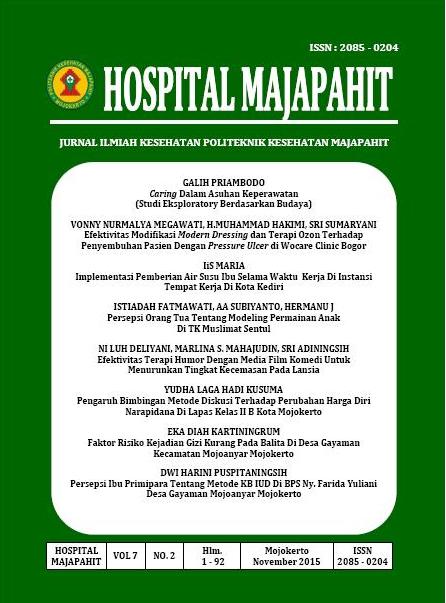CARING DALAM ASUHAN KEPERAWATAN (Studi Eksploratory Berdasarkan Budaya Pasien)
Abstract
Caring is the central focus or core of nursing (Watson, 2009). Level of caring as an evaluation of health services in this era. Caring is an emerging concept of self or individual personality, because as another concept that is formed on the basis of social interaction, according Kagitcibasi and Berry (1989) in Santrock (2008) The concept of having one's behavior is a cross-cultural variation is influenced by the culture in which he lives. The statement above is the background of researchers studied, caring nurses categories based culture. Exploratory research design was used, the sample using purposive sampling with 7 patients in hospitals PKU Muhammadiyah Bantul. Retrieval of data using in-depth interviews with semi tersektruktur question. Discussions with experts, caring based culture. The results of the interview showed caring categories according to the patient are: Attitude, Basic human needs, Spiritual, Information, Motivation, Communication Skills, Relationship Mutual Trust, Expression. The results of discussions with experts according to the patient's nursing category caring influenced by eastern culture.The conclusion of this study states that nurses caring category in accordance with the eastern culture. The statement shows a nurse caring influenced by, where the nurses lived.
Metrics
References
Alligood, M.R., Tomey, A.(2010). Nursing Theorists and Their Work. Mosby. Arwani. (2007). Komunikasi Dalam Keperawatan. EGC.
Asmadi. (2008). Teknik Prosedural Konsep & Aplikasi Kebutuhan Dasar Klien. Penerbit Salemba.
Burnard, P., Morrison, P. (2009). Caring and Communicating Hubungan Interpersonal dalam Keperawatan. EGC.
Chawani, F.S. (2009). Patient Satisfaction with Nursing Care: A Meta Synthesis. University of the Witwatersrand.
Irvine, L. (2008). Understanding the experience of older people in acute health care. Queen Margaret University
Kenney, Paula J. Christensen & Janet W. (2009). Proses Keperawatan : Aplikasi model konseptual ed 4. EGC.
KKBI, P. B. (2005). Kamus besar bahasa Indonesia Pusat Bahasa. Gramedia Pustaka Utama. Kridalaksana, harimurti. (2001). Wiwara: pengantar bahasa dan kebudayaan Jawa. Gramedia Pustaka Utama.
Mitra. (2006). SOSIOLOGI: - Jilid 2. ESIS.
Morse, J.M., richards, L. (2013). Readme first for a user’s guide to qualitative methods. SAGE Publications,Inc.
Newhouse, R.P., Stanik-Hutt, J., White, K.M., Johantgen, M., Bass, E.B., Zangaro, G., Wilson, R.F., Fountain, L., Steinwachs, D.M., Heindel, L., Weiner, J.P. (2011). Advanced practice nurse outcomes 1990-2008: a systematic review.(CNE SERIES). Nursing Economics 11.
Nursalam. (2008). Pendidikan Dalam Keperawatan. Penerbit Salemba.
Pawito. (2007). Penelitian komunikasi kualitatif. PT LKiS Pelangi Aksara, 104. Santrock, J. (2008). Adolescence. Erlangga PT.Gelora Aksara Ptratama.
Smith. (2012). Caring in Nursing Classics: An Essential Resource. Springer Publishing Company.
Tilaar, H. (2013). Filsafat Timur, Kearifan Lokal Dalam Pendidikan Watak. Sikap Mental dimajukan oleh Prof. Koentjaraningrat. Konfrensi Koentjaraningrat Memorial Lecture X FISIP, Universitas Indonesia.
Utami. S. (2008). Psikologi Umum. Jurnal Gunadarma.
Utomo, T. T. (2007). Mencegah & Mengatasi Krisis Anak . Grasindo.
Watson, J. (1999). Nursing: Human Science and Human Care: a Theory of Nursing. Jones & Bartlett Learning.
Watson, J., Foster, R. (2003). The Attending Nurse Caring Model®: integrating theory, evidence and advanced caring–healing therapeutics for transforming professional practice. Journal of clinical nursing 12, 360–365.
Watson, J. (2009). Assessing and Measuring Caring in Nursing and Health Science: Second Edition. Springer Publishing Company.
Watson, J. (2011). Human Caring Science. Jones & Bartlett Publishers.
Yani, Achir. (2008). Asuhan Keperawatan Kesehatan Jiwa Bunga Rampai. EGC

















